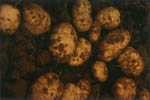
The bacterium, Streptomyces scabies, is present in most soils and it can survive for a number of years in the absence of a potato crop. It causes an unsightly disease of potatoes that affects grade quality but not yield or storability. The bacteria are spread by infected tubers and infested soil. The pathogen may be found in soils (particularly those that are heavily manured) where it thrives as a saprophyte on decaying plant parts. Scab lesions form on a range of crops such as beets, turnips and fibrous rooted plants. Potato tubers, stems, stolons and roots can become infected.
Common scab is affected by soil conditions. Soil moisture is the most important factor. Infections are more likely to occur when the soil is warm and dry and can be particularly severe if these conditions occur during the early stages of tuber formation. Soil pH is also a factor. Generally, soil pH values above 5.4 favour infections; however, there have been cases of infections at pH 5.2 or lower. Addition of fresh barnyard manure to soil favours the survival of the organism and scab infections.
